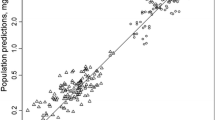Summary
The effects of liver enzyme induction and of urine pH on the pharmacokinetics of chlorpropamide have been studied. A single oral dose of chlorpropamide 250 mg was administered to 8 patients on antiepileptic drugs (phenytoin, carbamazepine) and to 8 healthy volunteers. The half-life of chlorpropamide was significantly shorter in the patients (34.4 h) than in the healthy volunteers (50.2 h), but the difference between the groups in the half-life of antipyrine was even more pronounced (5.1 vs 11.4 h). The clearance and volume of distribution of total chlorpropamide were significantly higher in the patients (2.99 ml·h−1·kg−1 and 126 ml·kg−1) than in the healthy volunteers (1.60 ml·h−1·kg−1 and 106 ml·kg−1). The unbound fraction of chlorpropamide in serum was also higher in the patients (5.7%) than in the healthy subjects (4.4%). Neither the volume of distribution nor the clearance of the free fraction of chlorpropamide differed significantly between the groups. There was a significant correlation between the half-lifes of chlorpropamide and antipyrine, and the half-life of chlorpropamide also had at least as good an inverse correlation with the urinary excretion of unchanged chlorpropamide. The renal clearance of chlorpropamide correlated well with urine pH and was almost 100-fold higher at pH 7 than at pH 5. Both the metabolic and renal clearances of chlorpropamide are important in its elimination. At urine pH higher than 6.5–7, the renal clearance of chlorpropamide represents more than half its total clearance regardless the degree of induction of liver enzymes.
Similar content being viewed by others
References
Melander A, Sartor G, Wåhlin E, Scherstén B, Bitzén P-O (1978) Serum tolbutamide and chlorpropamide concentrations in patients with diabetes mellitus. Br Med J 1: 142–144
Bergman U, Christenson I, Jansson B, Wiholm E-E, Östman J (1980) Wide variation in serum chlorpropamide concentration in outpatients. Eur J Clin Pharmacol 18: 165–169
Huupponen R, Viikari J, Saarimaa H (1982) Chlorpropamide and glibenclamide serum concentrations in hospitalized patients. Ann Clin Res 14: 119–122
Sartor G, Melander A, Scherstén B, Wåhlin-Boll E (1980) Influence of food and age on the single-dose kinetics and effects of tolbutamide and chlorpropamide. Eur J Clin Pharmacol 17: 285–293
Johnson PC, Hennes AR, Driscoll T, West KM (1959) Metabolic fate of chlorpropamide in man. Ann NY Acad Sci 74: 459–470
Brotherton PM, Grieveson P, McMartin C (1965) A study of the metabolic fate of chlorpropamide in man. Clin Pharmacol Ther 10: 505–513
Taylor JA (1972) Pharmacokinetics and biotransformation of chlorpropamide in man. Clin Pharmacol Ther 13: 710–718
Skillman TG, Feldman JM (1981) The pharmacology of sulfonylureas. Am J Med 70: 361–372
D'Ambrosio GG (1981) Chlorpropamide metabolism. Am J Med 71: 1050
Cambell RK, Hansten PD (1981) Metabolism of chlorpropamide. Diabetes Care 4: 332
Balant L (1981) Clinical pharmacokinetics of sulphonylurea hypoglycaemic drugs. Clin Pharmacokinet 6: 215–241
Dalgas M, Christiansen IB, Kjerulf K (1965) Fenylbutazon-induceret hypoglykaemitilfaelde hos klorpropamidbehandlet diabetiker. Ugeskr Laeg 127: 834–836
Kristensen M, Hansen JM (1968) Accumulation of chlorpropamide caused by dicoumarol. Acta Med Scand 183: 83–86
Petitpierre B, Perrin L, Rudhardt M, Herrera A, Fabre J (1972) Behaviour of chlorpropamide in renal insufficiency and under the effect of associated drug therapy. Int J Clin Pharmacol 6: 120–124
Self TH, Morris T (1980) Interaction of rifampin and chlorpropamide. Chest 77: 800–801
Neuvonen PJ, Kärkäinen S (1983) Effects of charcoal, sodium bicarbonate, and ammonium chloride on chlorpropamide kinetics. Clin Pharmacol Ther 33: 386–393
Raghow G, Meyer MC (1981) High-performance liquid chromatographic assay of tolbutamide and carboxytolbutamide in human plasma. J Pharm Sci 70: 1166–1168
Prescott LF, Adjepon-Yamoah KK, Roberts E (1973) Rapid gas-liquid chromatography estimation of antipyrine in plasma. J Pharm Pharmacol 25: 205–207
Kupferberg HJ (1970) Quantitative estimation of diphenylhydantoin, primidone and phenobarbitol in plasma by gas-liquid chromatography. Clin Chim Acta 29: 283–288
Welles JS, Root MA, Anderson RC (1959) Urinary metabolites of chlorpropamide in dogs, rabbits, and man. Proc Soc Exp Biol Med 101: 669–671
West KM, Johnson PC (1960) Metabolism and relative hypoglycaemic potencies of four sulfonylureas in man. Diabetes 9: 454–458
Gilman AG, Goodman LS, Gilman A (1980) The pharmacological basis of therapeutics, 6th edn. Macmillan New York p 1512
Huupponen R, Lammintausta R (1981) Chlorpropamide bioavailability and pharmacokinetics. Int J Clin Pharmacol Ther 19: 331–333
Taylor T, Assinder DF, Chasseaud LF, Bradford PM, Burton JS (1977) Plasma concentrations, bioavailability and dissolution of chlorpropamide. Eur J Clin Pharmacol 11: 207–212
Wikholm B-E (1980) Irregular drug intake and serum chlorpropamide concentrations. Eur J Clin Pharmacol 18: 159–163
Kärkkäinen S, Vapaatalo HI, Neuvonen PJ (1983) Urine pH is important for chlorpropamide elimination. Diabetes Care 6: 313
Fernández MC, Erill S, Lucena MI, Pita E, Pérez-Alférez (1985) Serum protein binding of tolbutamide in patients treated with antiepileptic drugs. Clin Pharmacokinet 10: 451–455
Syvälahti EKG, Pihlajamäki KK, Iisalo EJ (1974) Rifampicin and drug metabolism. Lancet 2: 232–233
Author information
Authors and Affiliations
Rights and permissions
About this article
Cite this article
Neuvonen, P.J., Kärkkäinen, S. & Lehtovaara, R. Pharmacokinetics of chlorpropamide in epileptic patients: Effects of enzyme induction and urine pH on chlorpropamide elimination. Eur J Clin Pharmacol 32, 297–301 (1987). https://doi.org/10.1007/BF00607578
Received:
Accepted:
Issue Date:
DOI: https://doi.org/10.1007/BF00607578




